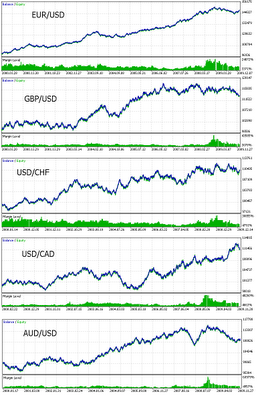However it is always interesting to look at the performance of systems on other currency pairs since it brings a hint about the differences between instruments, showing us why a system may work on one and not on another. Understanding and knowing the true nature of these differences allows us to develop systems that are “adapted” to each different currency pair’s trading nature. An analysis of these differences also allows us to change the design of a system- particularly its exit logic- to better exploit inefficiencies found in a particular instrument.
The first think I did with Watukushay FE was to run the “standard” settings derived from very coarse optimizations on the EUR/USD on the GBP/USD, USD/CHF, AUD/USD and USD/CAD (10 year backtests on Metatrader 5). The results are indeed good -as shown in the graphs below- in the sense that the system is profitable in the long term on all of these currency pairs, however it is important to say here that profitability is much lower than on the EUR/USD with most of these pairs reaching only a compounded yearly profit to maximum draw down ratio of 1:3 to 1:5. This shows us that the system tackles a market inefficiency that is present to a certain extent on all these currency pairs but unfavorable conditions are much more frequent than on the EUR/USD.
– –
–
It is evident when comparing the different equity curves that the smoothest of them is the EUR/USD which – of course – achieves the best results. We see that Watukushay FE has smooth periods of profit on most of these instruments but unprofitable periods are simply very destructive for the other pairs while they are only mild for the EUR/USD. Even tough the equity curves seem to show us that all instruments could be traded profitably the potential reward for instruments other than the EUR/USD is simply not enough to compensate for the risk taken. The deeper draw down periods also make Watukushay FE on other currency pairs far more difficult to trade also limiting risk escalation to a great extent.
However it is clear that some very interesting questions arise. Is it possible to do coarse optimizations on other pairs to find more EUR/USD-like results ? It is possible to implement small modification to the logic that improve the trading technique significantly ? Are there any other instruments worth trading for Watukushay FE besides the EUR/USD ? I will tray to address some of these questions on tomorrow’s post. If you would like to learn more about Watukushay FE and all the Watukushay Project experts please consider buying my ebook on automated trading or joining Asirikuy to receive all ebook purchase benefits, weekly updates, check the live accounts I am running with several expert advisors and get in the road towards long term success in the forex market using automated trading systems. I hope you enjoyed the article !




